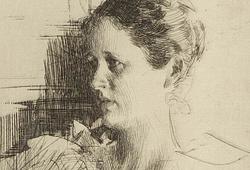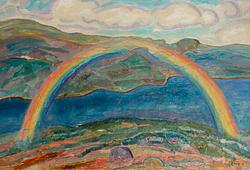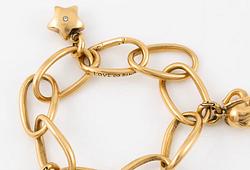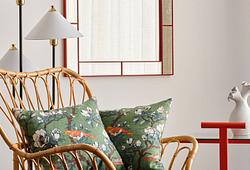Charles Despiau
"Apollon"
Signed C. Despiau. Conceived in 1937. Foundry mark C. Valsuani cire perdue, Bronze. Numbered 4/6. Bronze, dark patina. Height 116 cm (45 5/8 in.), total height including base 208 cm (81 7/8 in).
Provenance
Blanche's Konstgalleri, Stockholm.
Marabou Collection, Sundbyberg/Upplands-Väsby, Sweden (acquired from the above in 1950).
Kraft Foods Sverige AB, Upplands-Väsby, Sweden.
Exhibitions
Liljevalchs Konsthall, Stockholm, exhibition arranged by the friens of Moderna Museet, ”Cézanne till Picasso. Fransk konst i svensk ägo”, September 1954, catalogue no 427.
Literature
Nils Lindhagen and Alf Rolfsen, "Konst hos Freia och Marabou", 1955, mentioned and illustrated full page.
"Charles Despiau - sculptures et dessins", Musee Rodin, 1974, listed under the year 1937 as begun and described and illustrated, no. 98.
Ragnar von Holten, "Art at Marabou, a short guide", 1974, illustrated and mentioned p. 19.
Ragnar von Holten, "Art at Marabou", 1990, illustrated and mentioned, p. 15.
More information
Charles Despiau was born in Mont-de-Marsan in south-western France. At the age of 16, he was awarded a scholarship and left his hometown to study at the Écoles des Arts Décoratifs in Paris. Charles Despiau pursued his studies at the École des Beaux-Arts, where Auguste Rodin was one of the supervising professors. Classical studies did not appeal to him, however, since he did not consider anatomy to be of any significance to sculpture. He allegedly skipped certain classes in favour of visiting museums and exhibitions. As a student, Despiau became acquainted with other young sculptors, including Bourduelle and Camille Claudel, who belonged to the group “Les Jeunes Sculpteurs Indépendents”. Charles Despiau exhibited his work repeatedly with this group until the early 1920s. One exhibition in particular, the 1907 Salon de la Societé Nationale des Beaux-Art, was to change his working conditions radically, since he was “discovered” by Auguste Rodin, who immediately recruited him as his assistant. He continued to work for Auguste Rodin until 1914, when he was forced to go to war. Later, Charles Despiau undertook numerous assignments, including a teaching position at L'Academie de la Grande Chaumière. He also taught for a short period at L’Academie Scandinave, an art school run by Swedish, Norwegian and Danish artists, including Otte Sköld and Henrik Sörensen. Following a solo exhibition in 1930, he was commissioned to represent France at the Venice Biennale. Charles Despiau was also awarded the most prestigious French order, the Legion of Honour. One of his less respectable assignments was a short period as the teacher of Arno Brecker, who would later become the official sculptor of Nazi Germany. Charles Despiau was also passionate about fashion and participated frequently in contemporary discussions about what clothes were suitable for portrayal in sculptures and statues. Classical Greek draping was all very well, but it hardly reflected modern fashion trends. In his portrait sculptures, he therefore always depicted the current modes, and most of his early works are small figures portrayed in the latest styles of attire.
From the very beginning, Charles Despiau was a passionate, explorative sculptor, who could keep working for hours to achieve the desired result. His wife, Marie Despiau, and their circle of friends soon became accustomed to long sittings.
Charles Despiau achieved his greatest success as a portrait sculptor. He worked consistently in a realistic style, seeking to depict the model with the greatest possible veracity. His busts are characterised by the peace and serenity his models exude, a trait that is certainly evident in the sculpture in this auction.
Charles Despiau always worked in a classical spirit – the anatomical shapes should balance each other, and the sculpture should be as naturalistic as possible. This is particularly distinct in the sculpture of Apollo, which could serve as an example of his artistic legacy. Commissioned by the French Government in 1936, it was intended to stand outside the Musée d’Art Moderne in Paris. It was to be cast in a monumental format, and sketches were made for a cast measuring 5-7 metres. Unfortunately, the sculpture was never completed, partly due to the war and partly because Charles Despiau failed to deliver the work in time. The sculpture in the auction is thus a miniature original study. It reflects the Neo-Classicist ideals that prevailed in the 1930s, of which it is a beautiful example.
Charles Despiau is somewhat unique in early 20th century art. Despite his dislike of strict academicism, he was passionate about the classical ideals and, unlike other sculptors such as Maillol, never adopted any of the more modern styles. Charles Despiau was perhaps not the most revolutionary modernist, but he consistently followed his own path and eventually became a sought-after and popular sculptor. He was also highly prolific and left a vast number of sculptures, drawings, sketches, most of which are now in the museums of his native town, Mont-de-Marsan.
Completed in 1946 by Paul Belmondo.










































